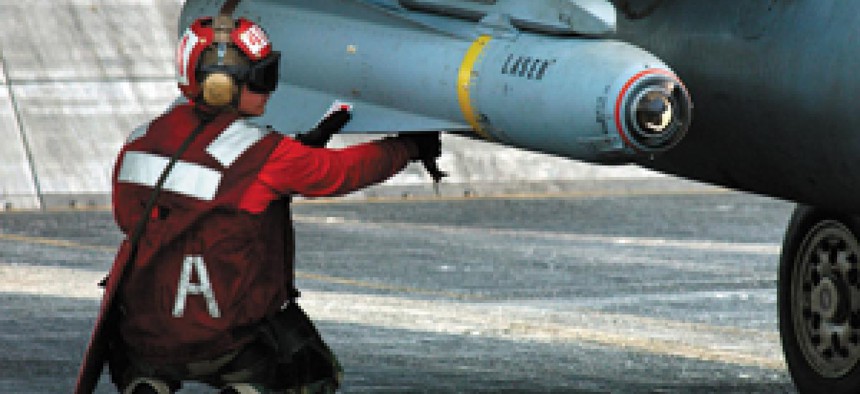Tech Success: Electronic weather manual helps Navy plan missions

When planning a mission, Navy warfighters must factor in how weather and ocean conditions might affect their weapons, sensors and platforms.
When planning a mission, Navy warfighters must factor in how weather and ocean conditions might affect their weapons, sensors and platforms.A crosswind at an airport could be dangerous based on the wind speed and load on an aircraft. In cold weather, a particular sensor could be affected by icing; or a missile system might need a certain level of visibility for a weapons officer or laser.In the early 1990s, the Navy published a 170-page document of all these limitations to help warfighters plan missions. But its usefulness was short-lived, said William Little, science and technology officer at the Naval Pacific Meteorology and Oceanography Center, Pearl Harbor, Hawaii."The minute the ink dried, the publication began to go out of date, because systems left the Navy, and new systems arrived," Little said.The obvious solution was to convert the paper-based publication--called Reference Publication-1, Environmental Effects on Weapons Systems in Naval Warfare--into an evolving, Web-based format.As part of that effort, the project took on relational database components to make it a more effective tool for mission planners, said Roger Yee, vice president of solutions engineering at BAE Systems North America Inc., Rockville, Md. BAE designed and installed RP-1, the new electronic publication.RP-1 assists in synthesizing and interpreting three pieces of information: the mission, the weather and the weather limits of the systems to be used in the mission, Yee said.To use that data, it provides the mission planner with a decision tool in the form of a graphic traffic light: green, the mission is good to go; yellow, the limits are being pushed; and red, the limits are being exceeded.Yee said the system, and the architecture it conforms to, could have other applications useful to systems integrators. For example, any project involving data sharing or synthesizing data from multiple sources would be a good fit for this technology, he said."Using this as a framework is a good starting point," he said.The use of open source and emerging industry standards such as Apache, Java and Extensible Markup Language, make the technology ready to integrate with existing and future systems, Yee said.That's a long way from a paper system so cumbersome that it was not widely used.One advantage of the Web-based RP-1 which resides on the Navy's Secure IP Router Network, is that registered users constantly help keep it up to date."Users nominate new limits and can make requests that other limits be considered out of date," Little said.Commanders on each ship can tweak the limits to their situation. The maximum wind speed for using circular parachutes is 13 miles an hour. In a warfare scenario, a commander might decide 14 miles an hour is acceptable, because it is so important to the mission to get the forces on the ground."Or he might decide it is peacetime and go with 10-mile-an-hour or less winds, because it is a training mission, and he doesn't want anybody to get hurt," Little said.One of the first challenges designers faced in designing RP-1 was conversion of the legacy systems."There were a couple of different publishing systems, databases and systems you never heard of because they were just legacy data formats," Yee said. "We had to write conversion tools and database manipulation tools to move all that into the new architecture."The second hurdle was designing a flexible system that wouldn't become obsolete in the near future, just as the legacy system had."We had to think about who the users are going to be 10 years from now, and what systems this will be part of 10 years from now," Yee said. "So the technical architecture pieces were very key."The use of XML and service-oriented or Web services architecture will likely make the system flexible enough to evolve over the next decade. It also will likely assist with finding other applications for the system.One future use will likely be for modeling and simulations."That's one example of how using XML and service-oriented architectures made the system capable of a use it was never destined to be used for," Yee said. "So, for a modeling and simulation application, RP-1 will become just another data feed."Although the system is not yet widely used, the Pacific fleet is using it for operations in Iraq and Afghanistan, Navy officials said. BAE officials expect other branches of the military, as well as public safety and first responder personnel, also will want to use the system.Yee predicted that use of RP-1 will likely increase sharply."The military is using more real-time collaboration and communication tools like chat and tools like NetMeeting," he said. "Applications like that will further extend the usability of the RP-1 architecture data into other systems."If you have an innovative solution that you recently installed in a government agency, contact Staff Writer Doug Beizer at dbeizer@postnewsweektech.com.


Petty Officer 3rd class William Miller arms an AGM-65 Maverick laser-guided missle mounted on an F/A-18 Hornet strike-fighter.
DefenseLink
NEXT STORY: M&A deals that say 'Wow!'